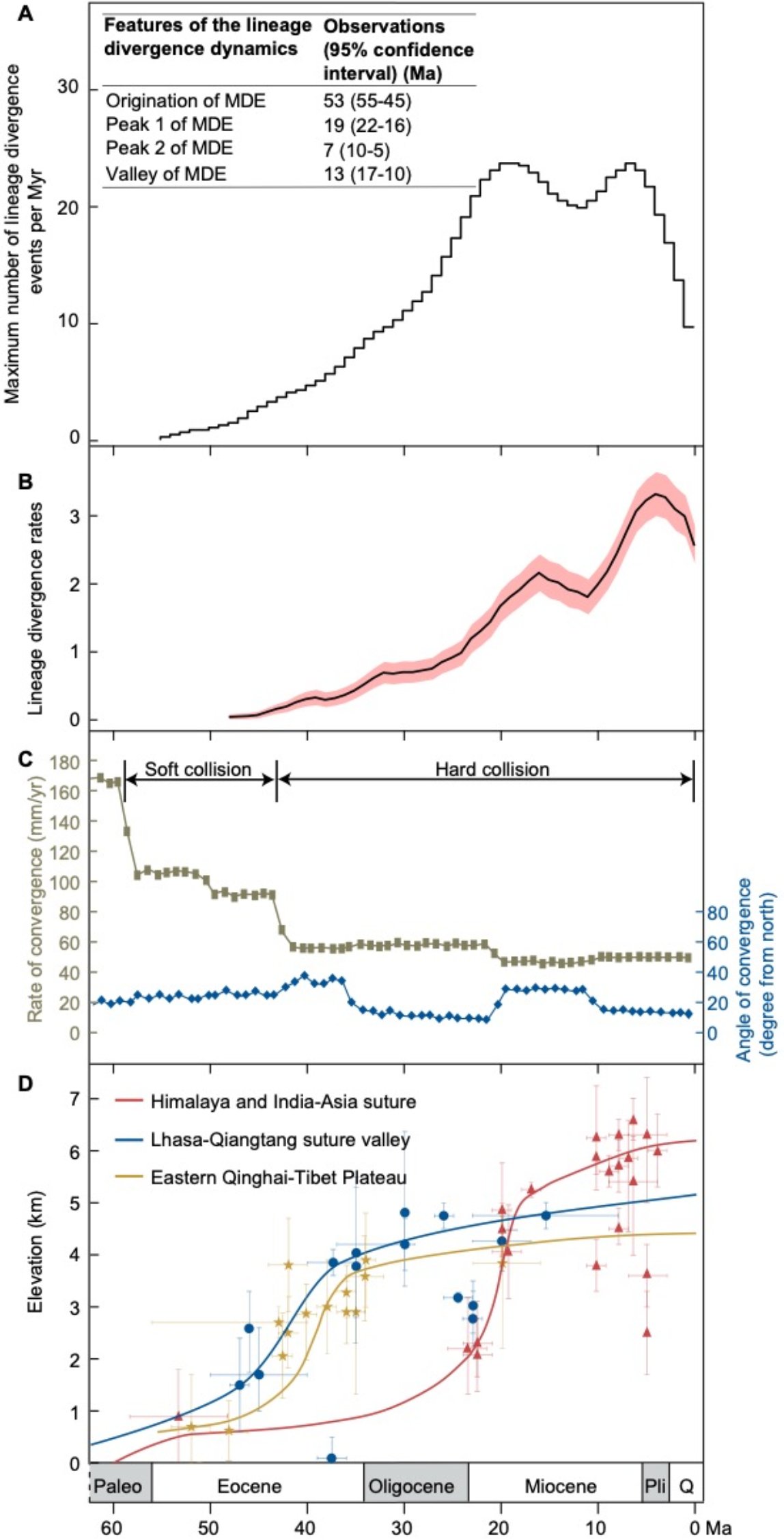A team led by Prof. WANG Wei from the Institute of Botany of the Chinese Academy of Sciences (IBCAS) has clarified the extrusion history of Indochina through a multi-taxon analysis. The study was published in PNAS.
The collision of India with Asia is one of the most significant tectonic events of Earth’s history. Following the initial collision in the early Cenozoic, this still ongoing convergence has caused the uplift of the Qinghai-Tibet Plateau and the extrusion of Indochina. This plate-scale extrusion has greatly changed Southeast Asian topography and drainage patterns and effected regional climate and biotic evolution.
Tectonic events affected biotic evolution; in turn, evolutionary diversification of organisms with poor dispersal ability might reflect the geological changes.
In this study, the researchers selected 42 plant and animal clades with 1721 species that are distributed across the ARSZ and are not expected to disperse across long distances. They found that the lineage divergences across the ARSZ were most likely associated with the Indochinese extrusion rather than climatic events. The lineage divergences began at ~53 Ma and increased sharply ~35 Ma, with two peaks at ~19 Ma and ~7 Ma, and one valley at ~13 Ma.
“We found that the lineage divergences across the Ailao Shan-Red River shear zone started in the early Eocene, and since then the divergences through time were not random but were largely confined to two periods of acceleration and decrease, coinciding with the changes of the India-Asia convergence rate and angle and the uplift of the Qinghai-Tibet Plateau during the early Eocene-late Miocene. Accordingly, we put forward a two-phase model for the extrusion of Indochina.” said Prof. WANG, correspondence author of the study.
The scientists provide biological evidence that illuminates the timing and mode of the Indochinese extrusion by integrating molecular dating and ancestral range reconstruction of multiple plant and animal clades in combination with ecological niche analysis. The estimates that we determined for the timing of the Indochinese extrusion along the ARSZ are key for understanding the geodynamics of the southeast margin of the Qinghai-Tibet Plateau, as well as the India-Asia collision.
"Our study highlights that a multi-taxon analysis can illuminate the timing of subtle historical events that may be difficult for geological data to pinpoint and can be used to explore other tectonic events.", said Prof. WANG.

Topographic map of the study area and the timing of the initiation and duration of the extrusion of Indochina (Image by IBCAS)

Timing and rates of the lineage divergences between the north and south ARSZ (Image by IBCAS)
A team led by Prof. WANG Wei from the Institute of Botany of the Chinese Academy of Sciences (IBCAS) has clarified the extrusion history of Indochina through a multi-taxon analysis. The study was published in PNAS.
The collision of India with Asia is one of the most significant tectonic events of Earth’s history. Following the initial collision in the early Cenozoic, this still ongoing convergence has caused the uplift of the Qinghai-Tibet Plateau and the extrusion of Indochina. This plate-scale extrusion has greatly changed Southeast Asian topography and drainage patterns and effected regional climate and biotic evolution.
Tectonic events affected biotic evolution; in turn, evolutionary diversification of organisms with poor dispersal ability might reflect the geological changes.
In this study, the researchers selected 42 plant and animal clades with 1721 species that are distributed across the ARSZ and are not expected to disperse across long distances. They found that the lineage divergences across the ARSZ were most likely associated with the Indochinese extrusion rather than climatic events. The lineage divergences began at ~53 Ma and increased sharply ~35 Ma, with two peaks at ~19 Ma and ~7 Ma, and one valley at ~13 Ma.
“We found that the lineage divergences across the Ailao Shan-Red River shear zone started in the early Eocene, and since then the divergences through time were not random but were largely confined to two periods of acceleration and decrease, coinciding with the changes of the India-Asia convergence rate and angle and the uplift of the Qinghai-Tibet Plateau during the early Eocene-late Miocene. Accordingly, we put forward a two-phase model for the extrusion of Indochina.” said Prof. WANG, correspondence author of the study.
The scientists provide biological evidence that illuminates the timing and mode of the Indochinese extrusion by integrating molecular dating and ancestral range reconstruction of multiple plant and animal clades in combination with ecological niche analysis. The estimates that we determined for the timing of the Indochinese extrusion along the ARSZ are key for understanding the geodynamics of the southeast margin of the Qinghai-Tibet Plateau, as well as the India-Asia collision.
"Our study highlights that a multi-taxon analysis can illuminate the timing of subtle historical events that may be difficult for geological data to pinpoint and can be used to explore other tectonic events.", said Prof. WANG.

Topographic map of the study area and the timing of the initiation and duration of the extrusion of Indochina (Image by IBCAS)

Timing and rates of the lineage divergences between the north and south ARSZ (Image by IBCAS)
